Ingo Pecher
Current gas hydrates research
ECOSSE PhD Studentship, Suzannah Toulmin: Quantitative Studies of Gas Hydrates, Offshore New Zealand
Seismic data collected recently by GNS Science reveal prominent amplitude anomalies within the gas hydrate stability zone east of New Zealand’s North Island (Crutchley et al., 2006; Pecher et al., 2007). These anomalies may mark gas hydrate “sweet spots”, areas of highly concentrated hydrates. Suzannah is planning to perform quantitative analyses of the seismic data and integrate results with controlled-source electromagnetic data acquired by IfM-Geomar and the Bundesanstalt für Geowissenschaften und Rohstoffe, Germany, in 2007, in order to constrain the subsurface distribution of gas and hydrates. The geologic setting of the gas hydrate system in the study area will also be investigated by tying seismic data into regional information at GNS Science in a first step towards analysing gas hydrate occurrences as possible part of the East Coast’s petroleum system.
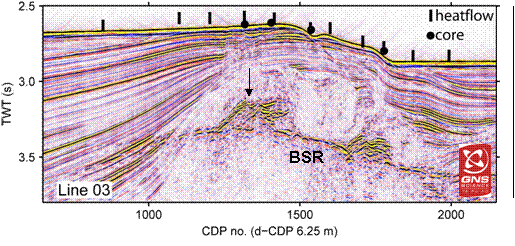
Amplitude anomaly (arrow) above bottom simulating reflection (BSR) marking the base of gas hydrate stability, Porangahau Ridge, Hikurangi Margin, New Zealand. Heatflow data and piston cores acquired by US Naval Research Laboratory (after (Pecher et al., 2007); data courtesy GNS Science).
Royal Society of New Zealand’s Marsden Fund: How do Gas Hydrates Weaken the Seafloor, Causing Submarine Slides and Tsunamis?
Ingo Pecher (GNS Science, now Heriot-Watt U. & ECOSSE, Edinburgh, UK), Susan Ellis (GNS), Steve Chiswell, Helen Neil (NIWA), Andrew Gorman (U. Otago), Nina Kukowski (GFZ Potsdam), 1/05-12/08.
Gas hydrate, an ice-like solid in which natural gas is trapped in cages of water molecules, has been identified globally as an important substance in the deep-water seafloor. Much of the research into gas hydrates is focussing on the vast energy resource they may constitute. It is becoming increasingly clear, however, that gas hydrates also represent a significant natural hazard. “Melting” of hydrate generates large volumes of gas that may weaken the seafloor, causing submarine landslides and tsunamis. New Zealand researchers have a unique opportunity to study the poorly-understood link between gas hydrates and seafloor instability. East of the North Island, in an area with abundant gas hydrates, an undersea ridge appears to be “chopped off” 600 m below sea level. At this depth, water temperatures vary over time and hydrates beneath the seafloor will repeatedly “melt” and “freeze”. We postulate that expansion and contraction during hydrate dissociation and formation may weaken the seafloor by a process similar to frost heave (Pecher et al., 2005). We propose to test the feasibility of this mechanism with a multidisciplinary study of the ridge and quantitative modelling. Results will be of fundamental significance for understanding how gas hydrates may cause submarine landslides and tsunamis.
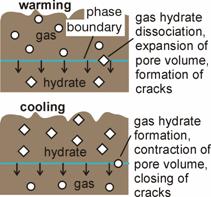 |
Hypothesis that repeated formation and dissociation of gas hydrates may lead to seafloor weakening and subsequent erosion on Rock Garden, Hikurangi Margin (after Pecher et al., 2005) |
Research in Edinburgh is focusing on analyzing seismic data acquired in 2006. Results will guide multi-phase fluid-flow modelling to estimate pressure from gas columns beneath the ridge and its role in seafloor weakening. This research is being conducted by Gareth Crutchley, a visiting PhD student from the University of Otago, Dunedin, New Zealand.
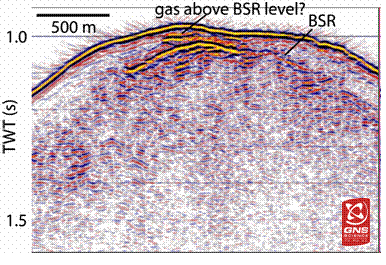
Gas close to the seafloor beneath Rock garden. Gas can lead to overpressure and cause fracturing of sediments and thus, weakening of the seafloor (data courtesy GNS Science)
MSc Individual Project 2007, Pablo G. García: Seismic Velocity Analysis of Ocean Bottom Seismometer Data from Gas Hydrate Bearing Sediments
Bottom simulating reflections (BSRs) in Lima Basin are confined to areas where the sub-surface structure is predicted to focus fluid flow (Pecher et al., 2001). Most BSRs seem to be caused by free gas at the base of gas hydrate stability (BGHS). An increase of fluid flow and hence, methane flux, across the BGHS is thought to “trigger” formation of BSRs once methane concentration exceeds its solubility in pore water. Enhanced methane flux should also lead to elevated gas hydrate concentration above the BGHS.
A BSR in the north of the basin coincides with outcropping layers, which often enhance fluid flow. During the GEOPECO campaign of the R/V Sonne in 2000, we deployed nine ocean bottom seismometers/hydrophones (OBS/Hs) at 1.85-km spacing across the termination of this BSR for a high-resolution OBS/H and short-streamer multichannel seismic transect. In order to investigate whether high gas hydrate concentrations are present in the hydrate zone, we compared velocities above the BSR to those in the same hydrate-free layer further landward. The OBS/H records were re-datumed to sealevel in the t-p domain followed by semblance analysis for determination of P-wave velocity (Vp). Vp in the same layer above the BSR appears lower than that at the hydrate-free site. This finding indicates that highly concentrated gas hydrates, if present at all, are confined to thin layers that don’t significantly affect Vp of the entire interval.
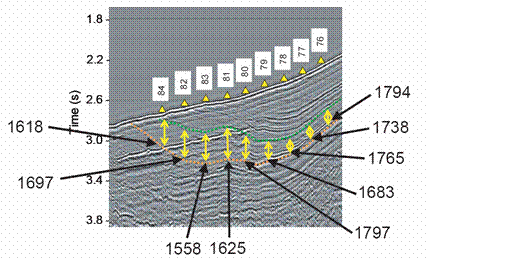
Interval velocities of the same layer in gas-hydrate-bearing sediments beneath OBSs 81-84 compared to those at hydrate-free reference sites beneath OBSs 79-76 (after García et al., 2007)
We have also identified at least two paleo-BSRs above the present BSR level. These paleo-BSRs most likely mark previous levels of the BGHS. Changes of the pressure/temperature regime must have happened sufficiently rapidly in order to “freeze” BSRs. We propose that the most likely mechanism for such rapid changes is sudden exhumation after mass wasting. The presence of at least two paleo-BSRs suggests that mass wasting has occurred repeatedly. Further quantitative studies will be required to investigate this hypothesis and its alternatives.
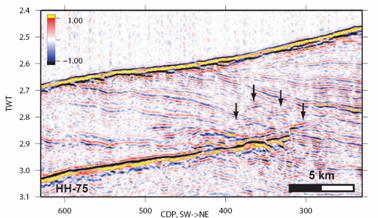
Paleo-BSR ("frozen BSRs", arrows) marking old levels of the base of gas hydrate stability
Acknowledgment: GNS Science is kindly giving us access to their seismic data for our New Zealand studies.
References:
Crutchley, G. J., I. A. Pecher, S. A. Henrys, and A. R. Gorman, 2006, Gas hydrate "sweet spots" on the Hikurangi margin, from recently acquired multi-channel seismic data, Proc. New Zealand Petrol. Conf., 7 pp.
García, P. G., I. A. Pecher, N. Kukowski, C. Huebscher, P. D. Clift, C. D. Ruppel, and J. Bialas, 2007, Analysis of High-Resolution OBS/H and MCS Data Across the Termination of a BSR in Lima Basin, Peru Margin – Velocity Structure and Paleo-BSRs, Suppl. to Eos, AGU Fall Meeting.
Pecher, I. A., R. Coffin, S. A. Henrys, and CHARMNZ Working Group, 2007, Cruise Report: gas hydrate exploration on the East Coast, North Island, New Zealand, 2007/29, 112 pp.
Pecher, I. A., S. A. Henrys, S. Ellis, S. M. Chiswell, and N. Kukowski, 2005, Erosion of the seafloor at the top of the gas hydrate stability zone on the Hikurangi Margin, New Zealand: Geophys. Res. Lett., 32, L24603.
Pecher, I. A., N. Kukowski, J. Greinert, C. Huebscher, J. Bialas, and G. W. Group, 2001, The link between bottom simulating reflections and methane flux into the gas hydrate stability zone -- new evidence from Lima Basin, Peru Margin: Earth Planet. Sci. Lett., 185, 343-354.
Please refer to the Centre for Gas Hydrates Research and the British Geological Survey for other gas hydrates projects within ECOSSE.

